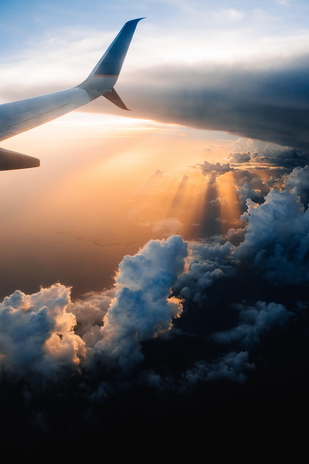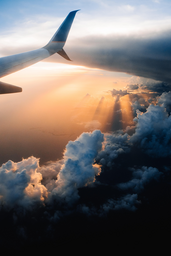Where are you studying abroad and with what program?
Quito, Ecuador with MSID Ecuador. The program consists of six weeks of classwork and 7 weeks working with an internship of our choice.
When did your program begin, and what are your top three moments so far?
We arrived for our program on September 1 and began classes and orientation activities on September 2. My top three moments would be the moments I have spent playing with my friends and our host families, hiking the TeleferiQo, and visiting Montanita with a group of DU students over a long weekend.
What has your experience been like in Quito, Ecuador during your stay?
Overall, the program has been a very interesting experience. Right now, Ecuador is in a time of extreme civil unrest. On October 2 of this year, Lenin Moreno announced a series of economic reforms to secure an International Monetary Fund loan that would start the following day. On October 3, the forty year fuel subsidies ended, leading to at least a 180% increase in gas prices. All buses, cargo trucks, and taxis stopped working in order to protest against the new reforms. Our parents told us that day to walk quickly through the streets and avoid speaking English in the street while the protests were happening, since the policies that put Ecuador in debt are American policies put forth during Bush’s presidency.
Fires were put into the streets and the protests descended into several cities throughout Ecuador. Security forces injured dozens of protestors through physical force and tear gas. The day ended with President Lenin ordering a 60-day state of emergency and Ecuador as a state of exception which allows the government to mobilize police and military personnel to control demonstrations, ban unauthorized gatherings, and limit the right to move freely within the country. By the end of October 4, the transportation strike had ended.
On October 8, nationwide protests from indigenous peoples continued, where fuel shortages began to be reported due to roadblocks along Ecuador’s major highways. The country’s state-run oil company announced that it had to suspend their operations in some of their oil fields due to protestors occupying their installations. Thousands of indigenous protestors stormed the National Assembly building after breaking through a security cordon, demanding that the reforms be reversed.
As well as ending Ecuador’s fuel subsidies, the government declared that they would be cutting the country’s vacation time in half and taking a day’s worth of pay per month public workers to help pay off the country’s $1.8b debt. Because of the new reforms, not only did the gas and diesel prices increase, but prices in all goods increased as well. These reforms not only are affecting a great majority of the middle class, but are destroying the lives of the lower class and indigenous peoples who live, on average, less than $1 a day. This is why people are upset and the people feel there is no one they can trust. The news are all biased and those who are not in favor of President Moreno have been discontinued for the time being.
Multiple unions have called for an indefinite national strike until Moreno agrees to reintroduce subsidies. Several of the large food markets have begun to partially or fully close down due to roadblocks disrupting the shipment of food to wholesalers, while other markets have closed due to looting fears. The Ecuadorian Red Cross has had to call for a suspension of ambulance services and announced that there is a shortage of blood as a result of the protests.
From October 7 to 9, more than 20,000 indigenous people began to make their way into Quito to begin their official protest starting on October 9. On October 10, Inocencio Tucubmi, an indigenous leader, died of brain trauma from a tear gas canister to the head during demonstrations against government inclemency measures. Over 800 people were detained and over 500 protestors were reported injured by the end of the day.
On October 11, things once again began to normalize, and I was able to continue with my normal daily activities around my house. This day is what I have decided to refer to as the “calm before the storm”, as October 12 became a historic day in being documented as one of the most violent days in the history of Ecuador.
On October 12, a curfew was ordered at 3 P.M., until the general public is advised otherwise; we were meant to stay in our homes as the street militarized as well. People’s water throughout Quito was cut off by protestors cutting lines in order to motivate people to get out and join the cause. The protests began to build more roadblocks throughout the city by catching different things on fire while also protecting themselves from bullets with only pieces of cardboard and walls made out of cement torn up from sidewalks. There was no sign of hope that things would end soon or peacefully. On this day, seven were killed, over 1500 were injured, and more than 1200 were detained.
On October 13, President Moreno lifted the curfew temporarily in order to allow for a dialogue meeting with the movement. While President Moreno and the leaders of of Indigenous Nationalities of Ecuador (CONAIE) were at the same table with equal status for the first time in Ecuadorian history, those still in the streets continued to protest until a deal was made. They reset public buildings on fire and continued to try and protect themselves, continuing the fight until there was no more fight left in them. After a five hour dialogue, President Moreno agreed to revoke Decree 883 in return for the violence to stop for everyone.
The country was left in relief and joy. The violence and times of fear for their own livelihoods were put at rest for the moment. People were guaranteed to get back to work and rebuild what had been destroyed. On October 14, the people began to work as a community to clean up the broken parts of the city and begin the process of restoration.
What does this mean for Ecuador now? What is their future? Because Decree 883 was what Ecuador needed for their part of the IMF loan, a lot is left in question of where Moreno and his government is going to find the money to replace the money Ecuador was meant to save by ending fuel subsidies. There are now more talks of possible peaceful protests by the workers’ unions for them to have a voice in the new version of Decree 883 beginning October 30.
Ecuador is a beautiful place filled with survivors, not just from the past week, but from the history of oppression the country holds. This month has been filled with heartache for the country and its people, but, also, a powerful sense of pride for the indigenous people. Although violence to achieve change is not something to promote, what is to be expected when the entire history of change in Ecuador has been based on violence? When people peacefully protest here, their voices are dismissed, unfortunately.
The situation in Ecuador should stand as a good example of how the IMF’s policies do not take into account what the citizens, especially that of the lower classes, have to lose. In a just world, the money would be coming from large corporations and the upper class to pay back the loans, but that is not the truth for many countries in similar situations or worse than Ecuador.
My time abroad has not been the typical study abroad, yet it has been filled with experiential learning while watching Ecuadorian history being made. My sustainability professor was one of the protestors and shared his experience with the class after classes were allowed to resume on Monday. He spoke of the support that people in the areas near the protests gave to the protestors. They cared for the protestors’ children, fed the protestors, and gave some of them a floor to sleep on.


